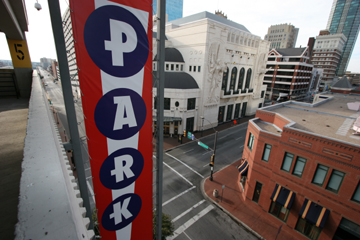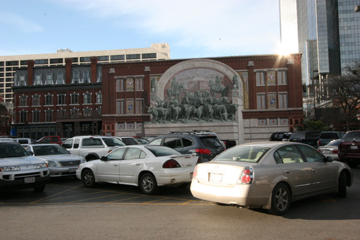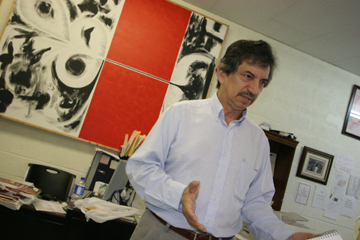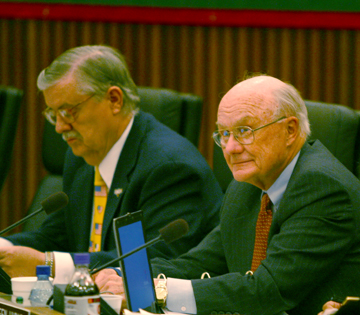It’s not that downtown didn’t have parking, it was just that people had gotten used to free parking in the suburbs. No one charged for parking out at shopping malls or at restaurants or nightclubs, and folks didn’t want to shell out five or 10 bucks to store their cars for a few hours. The Sundance Square group saw that in order to level the playing field and create a better market for retail, restaurants, and theaters downtown, there would have to be free p arking. So in 1988, they started letting the cars into one of their garages without charge on evenings and weekends.
arking. So in 1988, they started letting the cars into one of their garages without charge on evenings and weekends.
Over the years, city leaders and merchants have credited the free parking program for downtown’s booming redevelopment and its renewed role as a destination spot for people from all over the Metroplex. The perception among many is that the free parking program is a gift from the Basses and other garage owners, who forgo parking profits in order to build up downtown. Well, not anymore. For more than a decade, downtown garage owners have been getting paid handsomely in property tax dollars from the city, the Fort Worth school district, and Tarrant County Hospital District, among others, for allowing the public to use their garages. This year alone, taxpayers will fork over more than $3.1 million to lease 2,830 parking spaces from the Basses and others, thereby subsidizing “free” parking for folks who come downtown for a few drinks, a fine meal, or a show at Bass Hall.
You might think city leaders had carefully calculated how many spaces would be needed each year and made leasing decisions on that basis – but you would be wrong. In fact, the money subsidizes far more than parking – and in some cases, pays for parking spaces that don’t even exist yet. The money comes from the downtown tax increment financing district – a TIF, as it is called – and the free parking program is the biggest outlay of a district allegedly created to provide infrastructure for a “blighted” area of the city. The downtown TIF brings in $5 million a year, and last year handed out about $2.4 million to the parking lot owners. Because the TIF also kept more than $2 million in reserve, the parking payments represented a whopping 76 percent of its spending.
Fort Worth paid about $1.2 million for the “free” parking program, and the school district paid about $1 million. The county hospital district, which operates the John Peter Smith hospital system, kicked in another $325,000, an amount that’s drawing opposition from some hospital board members who see little justice in subsidizing a downtown parking program while charity healthcare for undocumented immigrants has been discontinued. JPS has built its own garage at the main hospital – a pay garage. So poor people visiting sick relatives have to pay, while JPS underwrites free spaces for folks attending shows at Bass Hall. Fort Worth now has 11 TIF districts, from the Texas Motor Speedway out north to the recently adopted Woodhaven TIF on the East Side. In all, in 2007, the Fort Worth TIFs collected $14.3 million in tax dollars and spent $9.6 million. The downtown free parking program accounted for 25 percent of the spending of all 11 districts combined. If revenues and expenses remain fairly constant in 2008, that figure will rise to 32.5 percent.
Most people interviewed for this story, from business leaders to elected politicians, said they had no idea that this much tax money was being spent on downtown parking. And the amounts have grown exponentially in recent years. The downtown TIF spent $400,000 to subsidize evening and weekend free parking in 2000; in 2008 the amount will be almost eight times that. “This program has flown under the radar, and I am shocked that the public is paying so much to subsidize private developers who own parking garages,” said Steve Hollern, a local taxpayer watchdog and former chairman of the Tarrant County Republican Party. “TIFs are supposed to be about infrastructure, about blight, but instead we subsidize these parking lot operators so people don’t have to pay for parking when they go out to eat downtown.”
While the downtown TIF has not hidden the fact that it subsidizes parking, members of the downtown TIF board interviewed for this story had little idea of how much the program has grown. The way the process works is that downtown business interests put together a wish list – projects they want to see TIF money spent on – and present it to Downtown Fort Worth Inc., the downtown business booster organization that oversees the TIF. Typically, the board rubberstamps the plan. “I sit on the [downtown TIF] board and did not know we are spending so much on this program,” said State Rep. Lon Burnam. “The argument can be made that the free parking program is a tool that boosts economic development downtown, but maybe we should study whether these parking spots are even needed. At some point, maybe the market takes over, and the free parking is no longer needed.”
The argument for the parking outlay is that it serves a dual purpose. The long-term parking leases “bridge the economic gaps that have occurred in downtown development projects, and we have found a way to kill two birds with one stone,” said Andy Taft, president of Downtown Fort Worth Inc. Taft emphasized that the long-term leases give real estate developers a dependable baseline income over several years, making it easier to attract investors to a project. “The developers need a comfort level, and the parking program strikes a balance between economic development and the need for parking,” Taft said. “The parking program allows the developers to finance these new developments long-term, and downtown get the free parking needed to keep the development robust.”
But some see the parking program as just another way for the city to funnel money to rich downtown business interests, while the rest of the city gets inferior services. “What is the quid pro quo for the community?” asked Hector Carrillo, president of the local League of United Latin American Citizens (LULAC) district. The Tarrant County Hospital District “can’t find the money to give healthcare for undocumented immigrants, but they can use their money to provide free parking for people going to Bass Hall. It’s always about downtown in this city, not the people who live in the neighborhoods. “Regardless of what these business people are saying, I doubt many people would not come downtown if they had to pay five dollars to park,” Carrillo said. “Plus they have all those free parking meter spaces on the street. So it’s free to park if you are going to see a show at Bass Hall or eat at a downtown restaurant. But if you want to visit a sick relative, you must pay for parking at John Peter Smith hospital. It doesn’t make any sense.”
 Hollern questioned whether downtown developers still need such incentives. “If everything is so vital and vibrant … as we are being told,” he said, “why do we have to guarantee subsidies for these developers so far in the future? The question no one wants to ask or answer is whether downtown … would be as vibrant without them.” TIFs were invented to give cities a means to attract investment to declining urban areas. California started them in the 1950s as a way to leverage federal grants, and other states followed suit over the years. Texas voters passed a constitutional amendment in 1981 that allowed cities to create TIFs. Fort Worth got into the act in 1995 with the Texas Motor Speedway TIF, followed by the downtown TIF the next year.
Hollern questioned whether downtown developers still need such incentives. “If everything is so vital and vibrant … as we are being told,” he said, “why do we have to guarantee subsidies for these developers so far in the future? The question no one wants to ask or answer is whether downtown … would be as vibrant without them.” TIFs were invented to give cities a means to attract investment to declining urban areas. California started them in the 1950s as a way to leverage federal grants, and other states followed suit over the years. Texas voters passed a constitutional amendment in 1981 that allowed cities to create TIFs. Fort Worth got into the act in 1995 with the Texas Motor Speedway TIF, followed by the downtown TIF the next year.
TIFs follow a basic premise: Take property tax receipts from one year as a baseline; in succeeding years, tax income above that level is retained to fund improvements within that district. For example, if a TIF district has a beginning property value of $100 million, and that grows to $125 million, the property taxes on the new $25 million are put into the TIF fund. The funding arrangement usually lasts 20 to 30 years. Over the years, the Texas TIF law has been amended to include areas that would never qualify as “blighted.” The law is now so vague that the Texas Motor Speedway, as well as downtown, can be categorized as blighted. In 2005, the state law was amended to allow TIF boards to “make grants and loans from the TIF fund for activities that benefit the zone and stimulate business and commercial activity.”
Parking is addressed in the law. TIFs can “acquire, construct, reconstruct, or install” parking facilities. “If you are leasing parking spaces, then you are acquiring those spaces,” said Debra Drayovitch, a local attorney who consults with smaller cities like Mansfield and Burleson on TIF issues. “The laws have changed to where TIFs can be city-initiated TIFs or ones initiated by the developers. They are about expanding economic development by giving incentives.” The initiatives come in many forms. The TIF around the Texas Motor Speedway was created for the sole purpose of getting money to the racetrack owners. The track is being purchased from its private owners by the Fort Worth Sports Authority, a quasi-governmental body, which means the $250 million property is no longer taxable. The authority is using about $400,000 per year in TIF funds to pay off the property – an odd way to fund economic development.
The TIF created for the Cabela’s hunting/fishing megastore in the Alliance Airport area likewise seems to have accomplished little in the way of economic development. The city put aside $40 million in TIF and other incentive funds for the private retailer, which used it to acquire the property and build the store. But there has been little development around the site. The city’s incentive agreement also called for Cabela’s to create 60 jobs for Fort Worth residents and 10 for “central-city” residents. In 2006, Cabela’s had just six Fort Worth and six central-city employees, and the company had to pay back about $71,000 to the city. The state’s Texas Enterprise Fund (TEF) also set employment goals for Cabela’s Fort Worth and Buda stores, a total of 400 jobs. The state fund paid $400,000 to Cabela’s up front, but by the end of 2006, the chain was 126 jobs short of the 400 promised. Cabela’s lost another $200,000 in grant money and had to pay the state back about $70,000 it had already received.
Cabela’s, which pushes for TIF help at its sites all around the country, lost more than $300,000 in all because it didn’t make good on its promises – but the property is already bought, the store built, and the company saved a couple of million dollars it would have had to pay in salaries and benefits to those 126 mythical workers. Not a bad bottom line. Cabela’s also made some grand promises about the number of people its store would draw to Fort Worth. The retailer said 6 million “visitors” would be coming to north Fort Worth every year. But Gander Mountain, another national chain of outdoor gear retailers, studied the number of cars coming into Cabela’s stores in 2006. David Ewald, a Gander spokesman, said researchers concluded that the Fort Worth store had just 1.3 million annual customers, of which only 14 percent had out-of-state license plates.
One TIF district that seems to have worked for the city is the one in the Medical District. The Near South Side TIF used its money to build a needed parking garage, provide infrastructure like new sidewalks and trees, give grants for new housing starts, and even pay for some capital improvement at neighborhood schools, such as a new roof for Trimble Tech High School. Fort Worth schools trustee Juan Rangel also sits on the board of the Medical District TIF. “There is that old saying that you have to give a little to get a little,” he said. “We have made sure that the South Side TIF does good economic development, and improvement in educational project infrastructures is a part of what we do. As for the benefit to the school district of the downtown TIF parking subsidies, Rangel said, “You can make the argument that the downtown parking investment has raised the amount of [overall tax] money the school district gets. What no one does is to study what would have happened if there was no TIF in place. What needs to be studied is whether that investment in parking was a good one or not.”
City officials trot out some big numbers on the downtown TIF – $322 million in property values when the TIF was started in 1995 and $881 million last year. But they could not produce any studies that compared the current downtown development situation to an estimate of what it would have been without the free parking and other TIF benefits. The downtown TIF board and city planners have not done any studies on how much the free parking has added to growth, nor have they looked extensively at how many parking spots are actually needed. The main objective is just to add more parking and give more money to the private developers.
Bill Boecker was the president and CEO of Sundance Square Inc. when the subject of a TIF first came up in the early 1990s. He is now president of Fine Line Diversified Development, a subsidiary of Sundance Square. According to published reports from that period, the downtown TIF was supposed to fund three projects: a city-owned parking garage, a downtown central park and plaza to be built on what is now the surface parking lot adjoining the Chisholm Trail mural, and fixing up the subway that ran from the old Tandy Center to free riverfront parking. None of those happened, for a number of reasons, and Boecker said free parking became the number-one issue for the TIF. “Back then, retail in downtown was not going good, and there was not much of it,” Boecker said. “And because we were competing with suburban shopping malls, free parking became what we needed.”
 Boecker said the city-owned parking garage was killed because experience in other cities showed that building a city-owned garage – at a cost of $20,000 per parking space – was too big of a risk. “Pay as you go was just the better way to go,” Boecker said. “And the free parking program was the linchpin in economic development for downtown.” But the Bass family provided free parking at their own expense before the TIF existed, so why did they and others have to be compensated after 1995? The answer was that developers wanted public money up front to lower the risk factor on new projects. “We needed a front-end arrangement to make deals happen,” Boecker said. “There was and is too much risk in doing these deals without the public/private partnership. What this is is an economic development tool under the name of parking.”
Boecker said the city-owned parking garage was killed because experience in other cities showed that building a city-owned garage – at a cost of $20,000 per parking space – was too big of a risk. “Pay as you go was just the better way to go,” Boecker said. “And the free parking program was the linchpin in economic development for downtown.” But the Bass family provided free parking at their own expense before the TIF existed, so why did they and others have to be compensated after 1995? The answer was that developers wanted public money up front to lower the risk factor on new projects. “We needed a front-end arrangement to make deals happen,” Boecker said. “There was and is too much risk in doing these deals without the public/private partnership. What this is is an economic development tool under the name of parking.”
In Fort Worth there is little political oversight of what TIFs do with their public dollars. The downtown TIF board, for instance, meets only a few times a year and generally approves the proposals of Downtown Fort Worth Inc. without debate.
Even the chairman of the downtown TIF board, Fort Worth City Council member Carter Burdette, wasn’t clear on what that agency spends under the heading of parking. “I am not sure how much money is spent,” on that, he said. Asked why the TIF doesn’t just pay the garage owners per car that uses the free parking, Burdette said, “It has not been determined if that is cost effective.” Burnam said he too was unaware that annual costs of the free parking program had passed the $3 million mark. Now that he knows, the board will look into it, he said. “When I hear that these numbers have gotten so huge, it is just the same old-same old – the rich getting richer. We will be asking some very hard questions. Because when I hear these numbers, they just slap me in the face.”
Donald Shoup, an urban planning professor at the University of California at Los Angeles, recently wrote The High Cost of Free Parking. The book challenges the traditional thinking that cheap and plentiful parking, especially in downtown areas, is smart public policy. “Parking free does not make for a good downtown, and I point to the fact that cities that do not have a parking problem are not great cities,” Shoup said. “Cities need to create programs that get people out of their cars by getting better mass- transit options and use the revenue from parking to do those things. But if you give free parking, you get locked into just providing more and more, because there is never enough of anything that is free.” Many cities in the country are now getting away from free parking in their downtown areas because of cost. Two years ago, Dallas ended its free-meter policy and has never subsidized private parking garages. Six months ago, San Jose, Cal., ended subsidized free parking and now charges $2 to $5 at city garages. A San Jose spokeswoman said city sales tax revenues dropped just 3 percent in the downtown district after the fees were increased. Austin does have free evening and weekend parking meters throughout the downtown area but does not extend the program to city- or private-owned garages.
Fort Worth’s combination of free curbside meters and private garage parking “is very peculiar,” Shoup said. “I have never heard of any city having so much free parking. I am sure there are much better uses for that money.” But he admitted he was not familiar with the transportation dynamics of Fort Worth. The underfunded bus system run by the Fort Worth Transportation Authority stops most of its routes at about 10 p.m. Since Fort Worth came of age in the automobile era – and since it’s in Texas – parking is a crucial factor in how people decide where to go and where to be entertained.
A key question is whether downtown Fort Worth’s popularity has reached the tipping point. Would visitors still come to downtown now even if they had to pay $3 or $5 to park in a secure garage?
David Porter, president of PNL Companies, the developer of the City Place project, said the $600,000 the city is spending for the City Place parking this year is “an overall economic development effort. I don’t think we have too much free parking. Surface parking is going away, and this is a very smart policy for planning for the future. We have to realize that here in Fort Worth, parking is critical in the choices people make.” This year, the TIF is paying City Place for spaces in two garages – including one that’s not yet operating. Porter said he understands the argument that free parking encourages more driving in an era of poor air quality, traffic congestion, and high gas prices. “We all want better mass transit and better energy efficiency, but anyone realistic knows we are not near that point here yet,” he said. “Most people in Tarrant County do not live near mass-transit options. So if the strength of downtown Fort Worth depends upon free parking, that is the cost that has to be borne.”
Taft echoed that sentiment. “There will be a point where we are so robust, and transit options are better, and then market-based parking might be a better option,” he said. “But the critical mass needed for that is still many years down the road.” Taking free parking out of downtown, Boecker said, would be “killing the goose that laid the golden egg. Look at Dallas. They have no free parking, and it looks like that.” As for free parking delaying mass- transit growth, Boecker pointed out that “killing downtown won’t be good for any new and improved mass-transit system.” It may be no accident that the TIF has never studied how much parking is actually needed to support the economic vitality of downtown. While the TIF leases 1,766 spaces in Sundance Square garages on Calhoun Street and at the Chase Bank building, free-parkers, on average, used only 60 percent of those spaces in 2007, according to Downtown Fort Worth Inc. As part of the deal to lease Chase Bank Sundance Square garage at 4th and Throckmorton streets, the downtown TIF reserved about 64 daytime parking spaces to be used by library patrons for up to 2 1/2 hours. On average, about 20 library patrons per day used the slots last year.
 “I would like to get more details on this free parking program, but it seems questionable,” said Fort Worth City Council member Chuck Silcox. “If we are spending $3.1 million in tax dollars, what do we get out of it? And why are we paying for spaces that are not being used? It would make more sense if they kept track of the cars using the free parking, and the garage operators get reimbursed from that number. Because the way it is run now, it sounds like we are wasting money on stuff that is not being used.” New York Times reporter David Cay Johnston is extremely critical of how TIFs are being used around the country. His book, Free Lunch: How the Wealthiest Americans Enrich Themselves at Government Expense (and Stick You with the Bill), was published this month by Penguin/Portfolio. “TIFs are promoted as a way to create economic development at no cost,” Johnston said in a phone interview with the Weekly. “But we all know there are no free lunches. It sounds like Fort Worth is paying for free parking, but who benefits? It’s the retail part of the economy, and that should never be subsidized.”
“I would like to get more details on this free parking program, but it seems questionable,” said Fort Worth City Council member Chuck Silcox. “If we are spending $3.1 million in tax dollars, what do we get out of it? And why are we paying for spaces that are not being used? It would make more sense if they kept track of the cars using the free parking, and the garage operators get reimbursed from that number. Because the way it is run now, it sounds like we are wasting money on stuff that is not being used.” New York Times reporter David Cay Johnston is extremely critical of how TIFs are being used around the country. His book, Free Lunch: How the Wealthiest Americans Enrich Themselves at Government Expense (and Stick You with the Bill), was published this month by Penguin/Portfolio. “TIFs are promoted as a way to create economic development at no cost,” Johnston said in a phone interview with the Weekly. “But we all know there are no free lunches. It sounds like Fort Worth is paying for free parking, but who benefits? It’s the retail part of the economy, and that should never be subsidized.”
Johnston pointed out that retail is at the end of the economic chain, and using tax money to prop up retail sales just moves consumer spending from one part of the city or region to another, rather than actually increasing overall spending. And he said the media has been lax in pointing out what TIFs really are. “If people knew these were just another way to move their hard-earned money from their pockets to the most wealthy folks in town, they would be outraged,” he said. “But no one pays much attention. These districts are growing all over the country” – Texas alone has created 25 of them in the last six years – “and the media either buys into the economic development lies being put forward or thinks this is just too complicated.” The operations of Fort Worth’s downtown TIF aren’t exactly at arm’s length, as is usually required in spending public money. Essentially, Downtown Fort Worth Inc. decides which garages get the free parking money and then distributes it to its members. Boecker is a board member; Sundance Square, parent company of the firm he heads, gets $761,758 a year from the free parking program. Taft said Boecker doesn’t vote on any issues that would benefit Sundance Square.
Paul Goebel, a finance professor at Texas Tech University who has studied TIFs, said the state laws are vague, but the use of funds for free parking “sounds like a stretch to me. Ultimately TIFs are about redeveloping an area that would not develop as quickly without the district. They are about infrastructure and streets and utilities. I’m not saying leasing parking spaces is illegal, but it is not what the legislation was about when it was passed.” Taft defended the parking program with the example of The Tower, the multi-million-dollar high-rise condo that was redeveloped in the old tornado-damaged Bank One building. That project wouldn’t have happened without public money, he said. The TIF helped pay for asbestos removal during the renovation and now pays TLC Green, the building’s owner, $832,904 a year to lease about 400 parking spaces. The lease is in effect for 10 more years, guaranteeing TLC Green $9.8 million. Few people probably know that, however – there are no signs at The Tower advertising the free parking, though web sites run by Downtown Fort Worth Inc. do mention it.
The Tower “had some real problems and sat for a long time after the tornado” in 2000, Taft said. “There were many who thought it would be torn down. And the conversion of an office to condominiums was a very risky venture. But the investment we made through TIF money, in both asbestos removal and parking, made the development happen. “Once it happened and succeeded, the downtown housing market really took off,” Taft said. “None of the new housing downtown would have happened as it did had The Tower not succeeded. The government agencies have seen their property tax revenue go up. So I would say it was a very good investment.” Taft said there was no conflict of interest in the downtown TIF awarding contracts to companies that are members of Downtown Fort Worth Inc. “There would be a conflict if we had a vote, but we don’t,” Taft said. “We work in partnership with city staff, and we make sure there are no conflicts.” The TIF board includes local elected officials such as Tarrant County Commissioner Roy Brooks and school board member Dr. Camille Rodriguez. Other members represent the business community – Jeff Rattikin of Rattikin Title Co. and Joy Webster, vice president of XTO Energy.
Any changes to the free parking program will be difficult to implement. Even if the market changes and people seem more willing to pay to park their cars, or if it is determined that so many parking spaces are not needed, the long-term leases require the city to keep on paying for at least 10 more years. And that makes a lot of people mad. “The amount of money that is going to these very rich developers under the guise of free parking is one of the most egregious things I have even seen, and I’ve witnessed a lot of them,” said Louis McBee, a former Fort Worth mayoral candidate who has long opposed the TIF programs. “There are very little controls over these TIFs, and everyone just sees free money. They all have their hands out.” “I wonder what free parking for people who go to shows and restaurants has to do with rejuvenating blighted parts of our city,” McBee said. “This is just further proof that this city has gotten away from what it should be doing, getting away from providing good services and keeping our tax rates down. It just keeps getting worse and worse.”
You can reach Dan McGraw at
dan.mcgraw@fwweekly.com.











